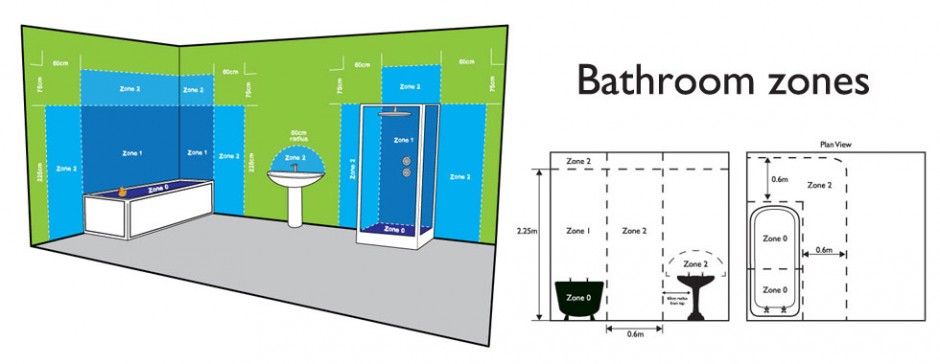Hi,
The installation is in Belgium. I was wondering if I could place a VMBGP2 in my bathroom in the second volume (less than 60cm from the bath).
RGIE says the power supply should be less than 25VAC and 60VDC so it’s good. But it also says I need IPX4 water protection. Is it the case? I can’t find information on it…
As far as I’m aware, the glass panels haven’t got any kind of IP / water resistance rating.
That said…
The VMBGP4 that I’ve got in my bathroom is working absolutely perfectly, as it has for the last 4 years.
The room is 5M x 2M, with the shower / bath in use daily.
But I need something that will pass the installation control…
Maybe if I fix it with silicon it should be ok? I’ll wait for a Velbus response 
Velbus glass control modules are IP20.
They should remain outside of the safety zones in wet areas (>2,4m in Belgium). The problem is not in the first place for the panels themselves. As MDAR also stated, they work fine in bathrooms. It’s a question of regulations and personal safety.
So I guess there is no module that could be in a bathroom correct?
So the only acceptable solution is using VMB7IN in combination with an IPX4 push button I still need to find…
It depends on the rating your local building inspector insists on.
If IP20 is acceptable, which I understand it is, as long as it outside of Zone 2 of the bathroom (previously known as Zone 3), the Glass Panels will be fine.
Does this help
In Belgium, we need IPX4 for volume 2 and IPX1 for volume 3 (so not compatible).
BUT, there is an alternative. I could power my whole Velbus installation with an TBTS transformer ( Safety Extra Low Voltage so galvanic isolation…).
So, in that case (TBTS power), as Velbus is powered at maximum 18VDC, I could only need an IP00 certification (for all volumes). So, if I correctly understood IP certification, it’s no certification (so IP20 is also ok right? )
Anyone knowing an isolation class 3 power module compatible?
I really think you need clarification from your building control office.
This really isn’t my area of expertise, the best I can do is find information and hope it helps you.
From this website, I found this —
Moisture
- IPX0 - no protection
- IPX1 - protection against vertical drops
- IPX2 - protection against drops at an angle of up to 15°
- IPX3 - protection against splash water * at an angle of up to 60°
- IPX4 - protection against splash water from every angle
- IPX5 - protection against spray water ** from every angle
- IPX6 - protection against powerful spray water and waves
- IPX7 - temporary protection against immersion (30 min)
- IPX8 - complete protection against immersion
- splash water = protected against splashing water, for example rain
** spray water = protected against water jets, for example from the shower
IP20
A spot with an IP20 value is only intended for dry rooms. The spot is not protected from dust. For example, an IP20 spot sometimes has holes to keep it cool. However, the spot is protected against contact with objects larger than 12.5 mm, such as your hand or finger.
OK, after a night on it. I think my alternative solution might not be good because of the bus itself. Since the bus interconnect all devices, this mean I would need galvanic isolation between the bus and all devices which I suppose is not the case ?
So the only solution is a push button like the niko 170-05000 which is IP41 (in volume 3) combined either with a VMB7IN or any push button interface (VMB8BPU probably to be able to have 2 switch side by side later)
VMB8PBU, VMB2PBN, VMB6PBN are not IP4x but the solution using a niko IP41 switch sending a signal to a galvanic input of a VMB7IN is the only solution
I thought that the enclosure of the switch being IP41 was enough… Thanks.
Then, the next interrogation is : Is the VMB7IN input galvanicly isolated? I doubt it…
Wait, that makes no sense…
There is no need for the VMB7IN to be isolated, nor for the VMB2PBN (…) to be IP41. Because you can have an IP41 switch connected to 220V non isolated… (We are in volume 3). That would be non-sense not being able to have something IP20 inside the switch…
After asking a electrician formator I know, the solution using the niko in volume 3 is indeed right.
And from his point of view, since there is no specification regarding non-power connection in the RGIE, it seems that even using a glass control panel in volume 2 is alright in the point of view of the legal regulation, with the condition that the power supply is galvanicly isolated (since it’s 15Vdc so, below the maximum of 30Vdc for IP00 apparel). That would mean another power supply that the Velbus one.
Though technically, since the bus is not isolated, it would be inappropriate. (There is still a possibility that your local controller would not like it if he’s very precautions, but it’s unlikely)
That’s excellent news.
Please thank your contractor for me.
